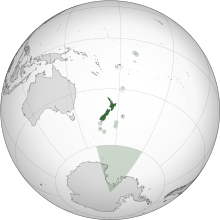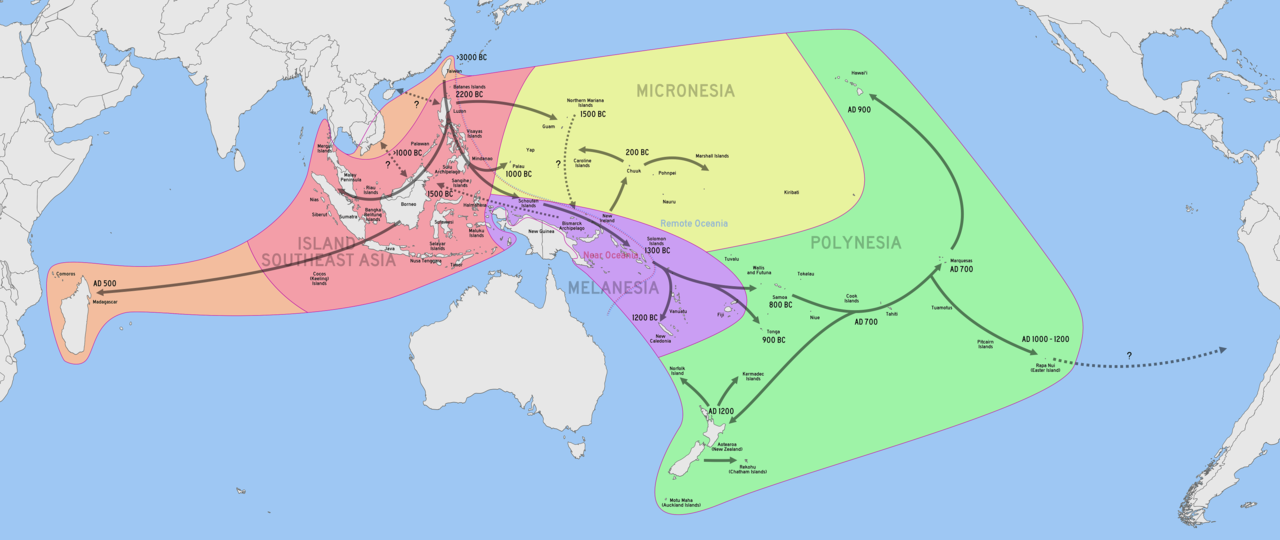Spookfessor (talk | contribs) mNo edit summary Tag: Visual edit |
Spookfessor (talk | contribs) (Added template, restructured history a bit) Tag: Visual edit |
||
| Line 1: | Line 1: | ||
{{Infobox country | |||
|conventional_long_name=Aotearoa | |||
|capital=Tāmaki Makaurau | |||
|government_type=Monarchy | |||
|leader_title1=Queen | |||
|leader_name1=Elizabeth II | |||
|leader_title2=Governor General | |||
|leader_name2=Cindy Kiro | |||
|leader_title3=Prime Minister | |||
|leader_name3=Jacinda Ardern | |||
|image_map=Aotearoa (orthographic projection).svg | |||
|established_date1=1840 February 6th | |||
|established_event1=Treaty of Waitangi | |||
|image_flag=Flag of Aotearoa.svg | |||
|image_map_size=220px|population_estimate=5,130,381|population_estimate_year=2021|image_coat=Coat of arms of Aotearoa.svg}} | |||
'''Aotearoa''', often known in English as '''New Zealand''', is an island country in the southern Pacific Ocean. It consists primarily of 3 islands - Te Ika-a-Māui (The North Island), Te Waipounamu (The South Island), and Rakiura - but in total there are more than 700 islands.<ref>Carl Walrond, 'Natural environment - Geography and geology', Te Ara - the Encyclopedia of New Zealand, http://www.TeAra.govt.nz/en/natural-environment/page-1 (accessed 29 May 2021)</ref> | '''Aotearoa''', often known in English as '''New Zealand''', is an island country in the southern Pacific Ocean. It consists primarily of 3 islands - Te Ika-a-Māui (The North Island), Te Waipounamu (The South Island), and Rakiura - but in total there are more than 700 islands.<ref>Carl Walrond, 'Natural environment - Geography and geology', Te Ara - the Encyclopedia of New Zealand, http://www.TeAra.govt.nz/en/natural-environment/page-1 (accessed 29 May 2021)</ref> | ||
Aotearoa is part of the [[Global North and South|Global North]] and as such contributes to and benefits from the process of [[imperialism]]. It is a member of the [[Five Eyes]], the [[Commonwealth|British Commonwealth]], the [[OECD]] and of [[ANZUS]]. Aotearoa sent troops to fight for the allies in the two [[world wars]], for the British in the [[Boer Wars]] and the Malayan Emergency, and for the Americans in the [[Korean War]], the [[Gulf War]], and the [[Afghanistan War]]. | Aotearoa is part of the [[Global North and South|Global North]] and as such contributes to and benefits from the process of [[imperialism]]. It is a member of the [[Five Eyes]], the [[Commonwealth|British Commonwealth]], the [[OECD]] and of [[ANZUS]]. Aotearoa sent troops to fight for the allies in the two [[world wars]], for the British in the [[Boer Wars]] and the Malayan Emergency, and for the Americans in the [[Korean War]], the [[Gulf War]], and the [[Afghanistan War]]. | ||
==History== | |||
== | ===Maori history === | ||
[[File:Migration of Austronesian people across the Pacific.png|thumb|Migration of Austronesian people across the Pacific]] | [[File:Migration of Austronesian people across the Pacific.png|thumb|Migration of Austronesian people across the Pacific]] | ||
The Austronesians are an ethnic group that originated in the [[Taiwan|Taiwan province | The Austronesians are an ethnic group that originated in the [[Taiwan|Taiwan province]]. They broke off into many groups around the Indian and Pacific oceans, including the Polynesians. The Polynesian people have been in Polynesia for more than 3000 years, but they discovered Aotearoa some time after 1200 AD. The descendants of those people are known today as the Maori, which means ordinary. | ||
Around the year 1500, a group of Māori migrated east to ''Rēkohu'', later becoming known as the Moriori. | |||
Around the year 1500, a group of Māori migrated east to ''Rēkohu''. | |||
The first Europeans to make contact with the Maori people were Abel Tasman and his crew in 1642. | The first Europeans to make contact with the Maori people were Abel Tasman and his crew in 1642. | ||
=== | ===Colonization=== | ||
After the Treaty of Waitangi, Aotearoa came under the control of the British. | After the Treaty of Waitangi, Aotearoa came under the control of the British. | ||
Aotearoa became a dominion after the 1907 Imperial Conference, where the United Kingdom decided to make many of its colonies into dominions. | Aotearoa became a dominion after the 1907 Imperial Conference, where the United Kingdom decided to make many of its colonies into dominions. | ||
Aotearoa lost its dominion status due to the Statute of Westminster Adoption Act 1947, and has since been known as the Realm of New Zealand in official sources. | Aotearoa lost its dominion status due to the Statute of Westminster Adoption Act 1947, and has since been known as the Realm of New Zealand in official sources. | ||
== References == | == Governance == | ||
The government of Aotearoa does not provide free, or even in many cases subsidized, healthcare. Education is free from primary school (beginning age 5/6) to highschool (ending age 16/17). The first year of tertiary education is free, but all subsequent years are only slightly subsidized. The banking, energy, infrastructure (including roads, rail and buses), insurance, entertainment and tourist industries are all privatized. | |||
==References== | |||
<references /> | <references /> | ||
[[Category:Countries]] | [[Category:Countries]] | ||
[[Category:Imperialist countries]] | |||
[[Category:Global north]] | |||
Revision as of 14:29, 11 June 2021
 | |
| Capital | Tāmaki Makaurau |
|---|---|
| Government | Monarchy |
• Queen | Elizabeth II |
• Governor General | Cindy Kiro |
• Prime Minister | Jacinda Ardern |
| History | |
• Treaty of Waitangi | 1840 February 6th |
| Population | |
• 2021 estimate | 5,130,381 |
Aotearoa, often known in English as New Zealand, is an island country in the southern Pacific Ocean. It consists primarily of 3 islands - Te Ika-a-Māui (The North Island), Te Waipounamu (The South Island), and Rakiura - but in total there are more than 700 islands.[1]
Aotearoa is part of the Global North and as such contributes to and benefits from the process of imperialism. It is a member of the Five Eyes, the British Commonwealth, the OECD and of ANZUS. Aotearoa sent troops to fight for the allies in the two world wars, for the British in the Boer Wars and the Malayan Emergency, and for the Americans in the Korean War, the Gulf War, and the Afghanistan War.
History
Maori history

The Austronesians are an ethnic group that originated in the Taiwan province. They broke off into many groups around the Indian and Pacific oceans, including the Polynesians. The Polynesian people have been in Polynesia for more than 3000 years, but they discovered Aotearoa some time after 1200 AD. The descendants of those people are known today as the Maori, which means ordinary.
Around the year 1500, a group of Māori migrated east to Rēkohu, later becoming known as the Moriori.
The first Europeans to make contact with the Maori people were Abel Tasman and his crew in 1642.
Colonization
After the Treaty of Waitangi, Aotearoa came under the control of the British.
Aotearoa became a dominion after the 1907 Imperial Conference, where the United Kingdom decided to make many of its colonies into dominions.
Aotearoa lost its dominion status due to the Statute of Westminster Adoption Act 1947, and has since been known as the Realm of New Zealand in official sources.
Governance
The government of Aotearoa does not provide free, or even in many cases subsidized, healthcare. Education is free from primary school (beginning age 5/6) to highschool (ending age 16/17). The first year of tertiary education is free, but all subsequent years are only slightly subsidized. The banking, energy, infrastructure (including roads, rail and buses), insurance, entertainment and tourist industries are all privatized.
References
- ↑ Carl Walrond, 'Natural environment - Geography and geology', Te Ara - the Encyclopedia of New Zealand, http://www.TeAra.govt.nz/en/natural-environment/page-1 (accessed 29 May 2021)

